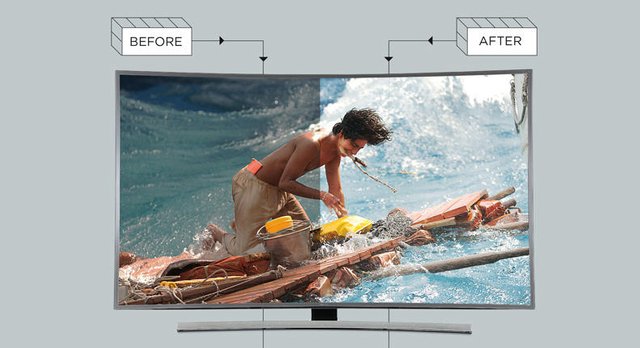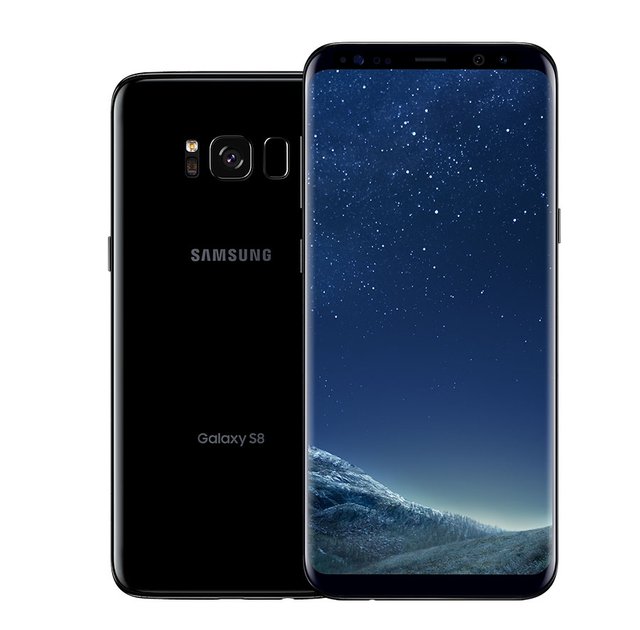Starting with 320x240 monochrome displays, technology has sure made exponential leaps forward over the last couple of decades. The end-goal has always been simple - to replicate fidelity that our eyes cannot distinguish between the display and reality. The recently released Galaxy S8 takes a major step forward, looking at the metrics observed by DisplayMate. So how far have we come?
Pixel density
This one is pretty well known and has been achieved for a while now. The goal is to make each pixel so small that your eye cannot distinguish between them. At 2960x1440 resolution over 5.8 inches, the Galaxy S8 has a 570 DPI display. This means, the average human can bring it 7 inch from their eyes and not see any pixels. On average, we use our phones from well over a foot away, so we have got this covered.

However, this is still not good enough for VR, where we are using the display from just 2 inches away. I'd say we would need ~2000 ppi to hit perfection. Prototype VR displays are starting to hit 800-1000 ppi, so we are getting there...
Dynamic range
Dynamic range is the ability to capture the brightest bright and the darkest darks. Our eyes have an incredible dynamic range of over 20 stops. In terms of contrast ratio this is about 1 million : 1. Currently, the very best LCD displays have a ratio of 2000:1, which, as you can tell, is simply not good enough. A high contrast ratio makes the image appear strikingly more vibrant.

Galaxy S8 uses an AMOLED display. Unlike LCD displays, OLED displays do not have any backlight. Hence, the blacks can be almost perfectly black as each pixel individually simply switches off. In effect, this means it has a near infinite contrast ratio.
But there's another aspect to dynamic range - brightness. The Galaxy S8's maximum brightness is 1,000 nits, which is absolutely unprecedented for a mobile display. It's still a million times off from what the Sun creates, but in a dark room, 1,000 nits is just about "good enough" to make for a pretty damn good illusion.
For these reasons, the S8 is the first display certified Mobile HDR Premium.
Colour gamut
Our eyes have a pretty narrow range over the visible spectrum. Nevertheless, it's much wider than anything today's displays can achieve.

The above diagram is the CIE diagram. The coloured space shows every colour the average human eye can see. For decades, the smaller yellow triangle, sRGB, has been the target colour space. As you can tell, that's barely a third of what our eyes are capable of.
The HDR standard is Rec.2100, the larger triangle. It still doesn't cover all possible colours, but it does cover pretty much every naturally existing object in the world.

The DCI-P3 yellow triangle is the current record for maximum colour gamut. This is the space used by cinema theatres. As you can see, the S8 takes another step forward, exceeding DCI-P3 in Adaptive Mode. That said, we are still some ways of Rec.2100. Still, the S8 can now cover most commonly occurring objects, save for some extreme colours.
Colour accuracy
Self explanatory - once S8 targets a certain gamut, different colours are checked and compared with reference values of what they should be. Each colour is checked for variations, measured by delta-E or JCND. For S8, the average delta-E is 2.7. This means even in a side by side comparison with the real colour, you'd be hard pressed to tell a difference. Anything under 6 is good, but anything under 3 is to the point of "good enough". Even the worst case scenario is under 6! That said, professional calibrations target a delta-E of under 1, though that's unnecessary for a consumer display. DisplayMate does not perform the more rigorous ColorChecker test - would love to see results on that.
Bezelless display
The S8 has a near bezelless display - it simply blends with the surroundings around the two side edges. There are still two bezels up top and bottom, though these have been minimised. One thing's for sure, it makes top phones from 2016 like iPhone 7 or Google Pixel look utterly archaic.

S8 is not the first phone to feature these either - Xiaomi's Mi Mix in fact even got rid of the top bezel by including a speaker behind the display! So some room for improvement here.
Refresh rate
The S8 doesn't innovate on this aspect, neither does it need to. S8 displays 60 frames per second, which is about standard for displays today. However, many gaming monitors go for 144 Hz, and some specialty monitors used by pro gamers even top out at 240 Hz. After 60 Hz there's diminishing returns, with about 100 Hz being more than good enough for most situations. Indeed, this is why VR is targeting 90 Hz. This is certainly doable given current technology, though for a mobile display anything above 60 Hz is a waste of battery life.
The acquisition equation
Of course, to display images, you have to first create them. Games and real-time graphics have a long, long way to go before they are photorealistic. However, modern cameras are nearly there already!

The RED Weapon Helium, for example, already records images at 8K. Granted, 8K is not enough for the largest IMAX screen, but it sure is more than enough for the TV, mobile and VR displays. At 16.5 stops of dynamic range, it's closing in on our eyes' 20. This is not a big deal anyway as movie productions use artificial lighting to limit the difference between the brightest bright and the darkest dark. Lastly, the Weapon shoots at 100 fps at 6K and 75 fps at 8K. These frame rates are good enough so motion appears smooth to our eyes.
One step forward, a couple more to go...
The Samsung Galaxy S8 takes a major step towards a realistic display - one that can accurately represent objects from the real world. The ultimate test would be a VR display which is indistinguishable from reality. We are still some ways off. The contrast ratio and brightness is almost good enough, the refresh rate certainly so. Colour gamut is getting there, though this could take a while. Finally, we have to get that pixel density up to 2,000 ppi. All of this should be achievable by 2020. It's been a dream since the beginning of human civilization to accurately recreate reality, and we are finally there, folks!
Image sources:
http://www.knowyourmobile.com/makes/20613/pixels-inch-ppi-what-it-means-and-how-its-calculated
https://www.whathifi.com/advice/hdr-tv-what-it-how-can-you-get-it
http://blog.extramaster.net/2016/09/srgb-vs-rec-2020rec-2100.html
https://news.samsung.com/us/discover-new-possibilities-samsung-galaxy-s8-galaxy-s8-plus-unpacked-2017/
http://www.red.com/products/weapon-8k#gallery
Amazing phone. I wish I can have one.
Downvoting a post can decrease pending rewards and make it less visible. Common reasons:
Submit
Yeah, but it's all about the display. Really, nothing much else new here apart from that. Expensive, but given how much people use their smartphones, well worth it.
Downvoting a post can decrease pending rewards and make it less visible. Common reasons:
Submit
Nice write up... maybe my next phone.
Downvoting a post can decrease pending rewards and make it less visible. Common reasons:
Submit
Might want to wait for the reviews. But yeah, most likely it'll be a solid buy!
Downvoting a post can decrease pending rewards and make it less visible. Common reasons:
Submit
This phone has a truly immersive display. But one must really love smartphones to appreciate its worth in full.
Downvoting a post can decrease pending rewards and make it less visible. Common reasons:
Submit
Very interesting summary of the underlying technology. Thank you.
Downvoting a post can decrease pending rewards and make it less visible. Common reasons:
Submit
There's a lot more to it, but hopefully this was a nice summary that'd open the average consumer's eyes to beyond the resolution wars.
Downvoting a post can decrease pending rewards and make it less visible. Common reasons:
Submit
Samsung is coming up with the samsung galaxy s9 phone,
Checkout : samsung galaxy s9 release date
Downvoting a post can decrease pending rewards and make it less visible. Common reasons:
Submit
checkout latest Samsung Secret codes on my website.search "rehanhub" in google.
Downvoting a post can decrease pending rewards and make it less visible. Common reasons:
Submit